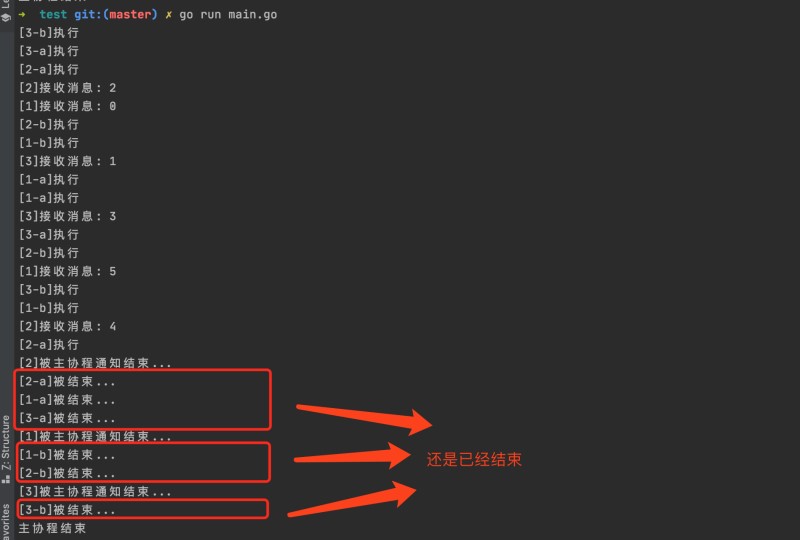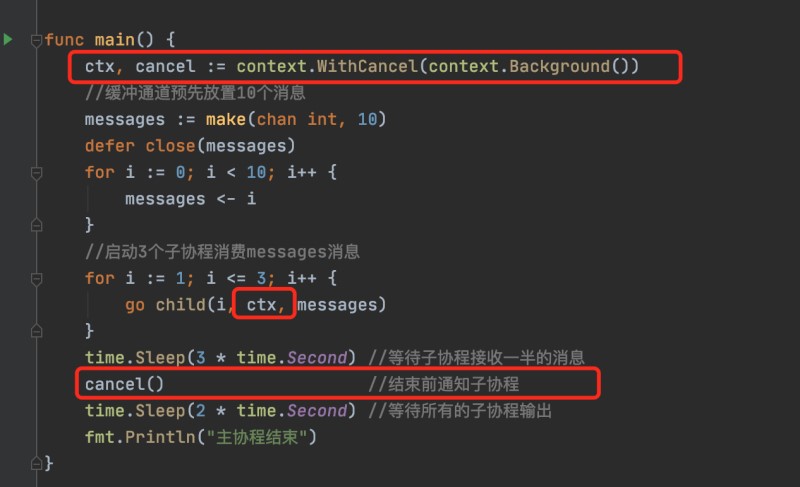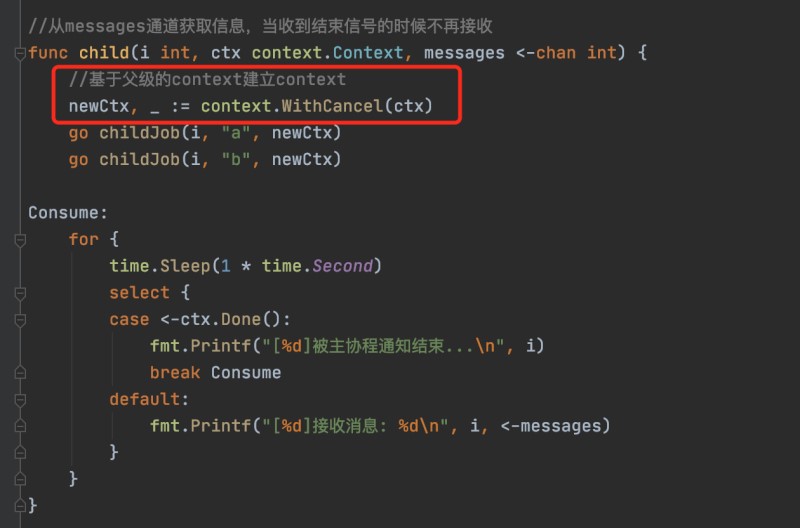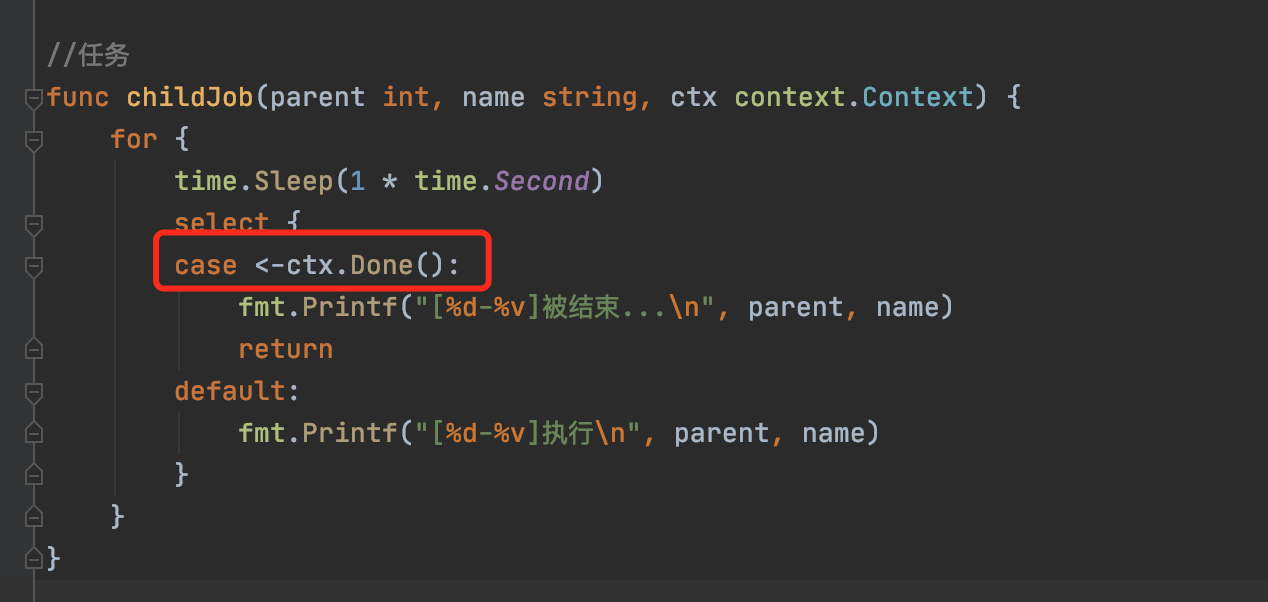您好,登錄后才能下訂單哦!
您好,登錄后才能下訂單哦!
本篇內容介紹了“go語言context包功能及操作使用的方法”的有關知識,在實際案例的操作過程中,不少人都會遇到這樣的困境,接下來就讓小編帶領大家學習一下如何處理這些情況吧!希望大家仔細閱讀,能夠學有所成!
我們會在用到很多東西的時候都看到context的影子,比如gin框架,比如grpc,這東西到底是做啥的?
大家都在用,沒幾個知道這是干嘛的,知其然而不知其所以然
原理說白了就是:
當前協程取消了,可以通知所有由它創建的子協程退出
當前協程取消了,不會影響到創建它的父級協程的狀態
擴展了額外的功能:超時取消、定時取消、可以和子協程共享數據
這就是context包的核心原理,鏈式傳遞context,基于context構造新的context
每一個 RPC 調用都應該有超時退出的能力,這是比較合理的 API 設計
不僅僅 是超時,你還需要有能力去結束那些不再需要操作的行為
context.Context 是 Go 標準的解決方案
任何函數可能被阻塞,或者需要很長時間來完成的,都應該有個 context.Context
在 RPC 開始的時候,使用 context.Background()
有些人把在 main() 里記錄一個 context.Background(),然后把這個放到服務器的某個變量里,然后請求來了后從這個變量里繼承 context。這么做是不對的。直接每個請求,源自自己的 context.Background() 即可。
如果你沒有 context,卻需要調用一個 context 的函數的話,用 context.TODO()
如果某步操作需要自己的超時設置的話,給它一個獨立的 sub-context(如前面的例子)
package main
import (
"context"
"fmt"
"time"
)
func main() {
ctx, cancel := context.WithCancel(context.Background())
//緩沖通道預先放置10個消息
messages := make(chan int, 10)
defer close(messages)
for i := 0; i < 10; i++ {
messages <- i
}
//啟動3個子協程消費messages消息
for i := 1; i <= 3; i++ {
go child(i, ctx, messages)
}
time.Sleep(3 * time.Second) //等待子協程接收一半的消息
cancel() //結束前通知子協程
time.Sleep(2 * time.Second) //等待所有的子協程輸出
fmt.Println("主協程結束")
}
//從messages通道獲取信息,當收到結束信號的時候不再接收
func child(i int, ctx context.Context, messages <-chan int) {
//基于父級的context建立context
newCtx, _ := context.WithCancel(ctx)
go childJob(i, "a", newCtx)
go childJob(i, "b", newCtx)
Consume:
for {
time.Sleep(1 * time.Second)
select {
case <-ctx.Done():
fmt.Printf("[%d]被主協程通知結束...\n", i)
break Consume
default:
fmt.Printf("[%d]接收消息: %d\n", i, <-messages)
}
}
}
//任務
func childJob(parent int, name string, ctx context.Context) {
for {
time.Sleep(1 * time.Second)
select {
case <-ctx.Done():
fmt.Printf("[%d-%v]被結束...\n", parent, name)
return
default:
fmt.Printf("[%d-%v]執行\n", parent, name)
}
}
}運行結果如下

可以看到,改成context包還是順利的通過子協程退出了
主要修改了幾個地方,再ctx向下傳遞

基于上層context再構建當前層級的context

監聽context的退出信號,

這就是context包的核心原理,鏈式傳遞context,基于context構造新的context
type Context interface {
Deadline() (deadline time.Time, ok bool)
Done() <-chan struct{}
Err() error
Value(key interface{}) interface{}
}Deadline返回綁定當前context的任務被取消的截止時間;如果沒有設定期限,將返回ok == false。
Done 當綁定當前context的任務被取消時,將返回一個關閉的channel;如果當前context不會被取消,將返回nil。
Err 如果Done返回的channel沒有關閉,將返回nil;如果Done返回的channel已經關閉,將返回非空的值表示任務結束的原因。如果是context被取消,Err將返回Canceled;如果是context超時,Err將返回DeadlineExceeded。
Value 返回context存儲的鍵值對中當前key對應的值,如果沒有對應的key,則返回nil。
實現了context接口,emptyCtx沒有超時時間,不能取消,也不能存儲額外信息,所以emptyCtx用來做根節點,一般用Background和TODO來初始化emptyCtx
通常用于主函數,初始化以及測試,作為頂層的context
context.Background()
不確定使用什么用context的時候才會使用
type valueCtx struct{ Context key, val interface{} }valueCtx利用Context的變量來表示父節點context,所以當前context繼承了父context的所有信息
valueCtx還可以存儲鍵值。
可以向context添加鍵值
func WithValue(parent Context, key, val interface{}) Context {
if key == nil {
panic("nil key")
}
if !reflect.TypeOf(key).Comparable() {
panic("key is not comparable")
}
return &valueCtx{parent, key, val}
}添加鍵值會返回創建一個新的valueCtx子節點
func (c *valueCtx) Value(key interface{}) interface{} {
if c.key == key {
return c.val
}
return c.Context.Value(key)
}可以用來獲取當前context和所有的父節點存儲的key
如果當前的context不存在需要的key,會沿著context鏈向上尋找key對應的值,直到根節點
package main
import (
"context"
"fmt"
"time"
)
func main() {
ctx := context.WithValue(context.Background(), "name1", "root1")
//第一層
go func(parent context.Context) {
ctx = context.WithValue(parent, "name2", "root2")
//第二層
go func(parent context.Context) {
ctx = context.WithValue(parent, "name3", "root3")
//第三層
go func(parent context.Context) {
//可以獲取所有的父類的值
fmt.Println(ctx.Value("name1"))
fmt.Println(ctx.Value("name2"))
fmt.Println(ctx.Value("name3"))
//不存在
fmt.Println(ctx.Value("name4"))
}(ctx)
}(ctx)
}(ctx)
time.Sleep(1 * time.Second)
fmt.Println("end")
}運行結果

可以看到,子context是可以獲取所有父級設置過的key
用來創建一個可取消的context,返回一個context和一個CancelFunc,調用CancelFunc可以觸發cancel操作。
package main
import (
"context"
"fmt"
"time"
)
func main() {
ctx, cancel := context.WithCancel(context.Background())
//第一層
go func(parent context.Context) {
ctx, _ := context.WithCancel(parent)
//第二層
go func(parent context.Context) {
ctx, _ := context.WithCancel(parent)
//第三層
go func(parent context.Context) {
waitCancel(ctx, 3)
}(ctx)
waitCancel(ctx, 2)
}(ctx)
waitCancel(ctx, 1)
}(ctx)
// 主線程給的結束時間
time.Sleep(2 * time.Second)
cancel() // 調用取消context
time.Sleep(1 * time.Second)
}
func waitCancel(ctx context.Context, i int) {
for {
time.Sleep(time.Second)
select {
case <-ctx.Done():
fmt.Printf("%d end\n", i)
return
default:
fmt.Printf("%d do\n", i)
}
}
}結果:

type cancelCtx struct {
Context
mu sync.Mutex
done chan struct{}
children map[canceler]struct{}
err error
}
type canceler interface {
cancel(removeFromParent bool, err error)
Done() <-chan struct{}
}返回一個基于parent的可取消的context,并且過期時間deadline不晚于所設置時間d
創建一個定時取消context,和WithDeadline差不多,WithTimeout是相對時間
timerCtx是基于cancelCtx的context精英,是一種可以定時取消的context,過期時間的deadline不晚于所設置的時間d
示例:
package main
import (
"context"
"fmt"
"time"
)
func main() {
// 設置超時時間
ctx, _ := context.WithTimeout(context.Background(), 2*time.Second)
//第一層
go func(parent context.Context) {
ctx, _ := context.WithCancel(parent)
//第二層
go func(parent context.Context) {
ctx, _ := context.WithCancel(parent)
//第三層
go func(parent context.Context) {
waitCancel(ctx, 3)
}(ctx)
waitCancel(ctx, 2)
}(ctx)
waitCancel(ctx, 1)
}(ctx)
<-ctx.Done()
// 給時間調用end
time.Sleep(time.Second)
}
func waitCancel(ctx context.Context, i int) {
for {
time.Sleep(time.Second)
select {
case <-ctx.Done():
fmt.Printf("%d end\n", i)
return
default:
fmt.Printf("%d do\n", i)
}
}
}運行結果:
1 do 3 do 2 do 1 end 3 end 2 end
可以看到,雖然我們沒有調用cancel方法,5秒后自動調用了,所有的子goroutine都已經收到停止信號
Done方法返回一個channel
外部通過調用<-channel監聽cancel方法
cancel方法會調用close(channel)
當調用close方法的時候,所有的channel再次從通道獲取內容,會返回零值和false
res,ok := <-done:
過期自動取消,使用了time.AfterFunc方法,到時調用cancel方法
c.timer = time.AfterFunc(dur, func() {
c.cancel(true, DeadlineExceeded)
})“go語言context包功能及操作使用的方法”的內容就介紹到這里了,感謝大家的閱讀。如果想了解更多行業相關的知識可以關注億速云網站,小編將為大家輸出更多高質量的實用文章!
免責聲明:本站發布的內容(圖片、視頻和文字)以原創、轉載和分享為主,文章觀點不代表本網站立場,如果涉及侵權請聯系站長郵箱:is@yisu.com進行舉報,并提供相關證據,一經查實,將立刻刪除涉嫌侵權內容。